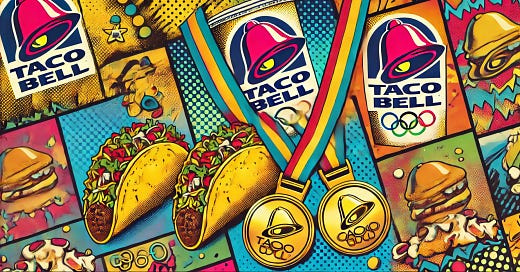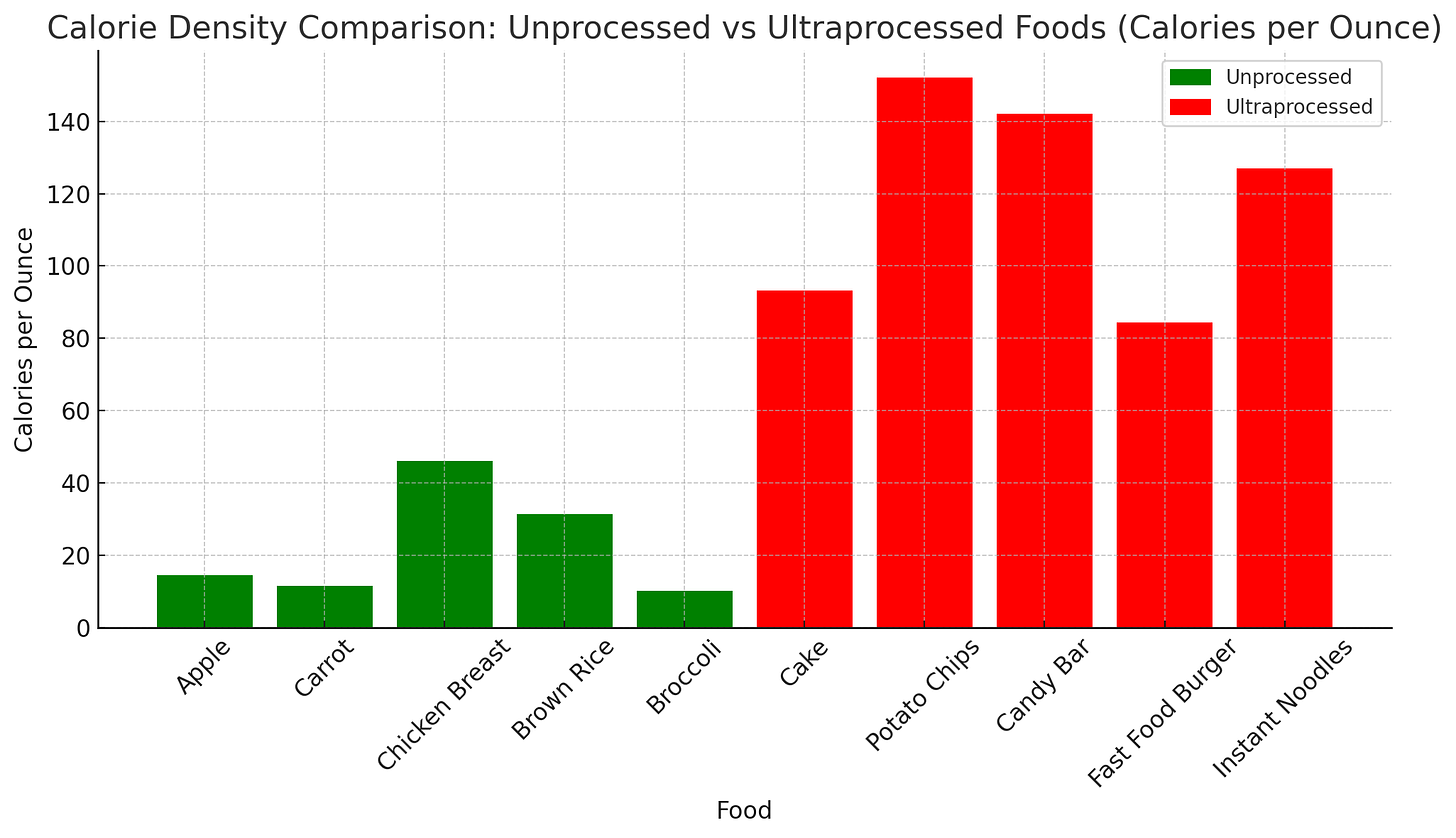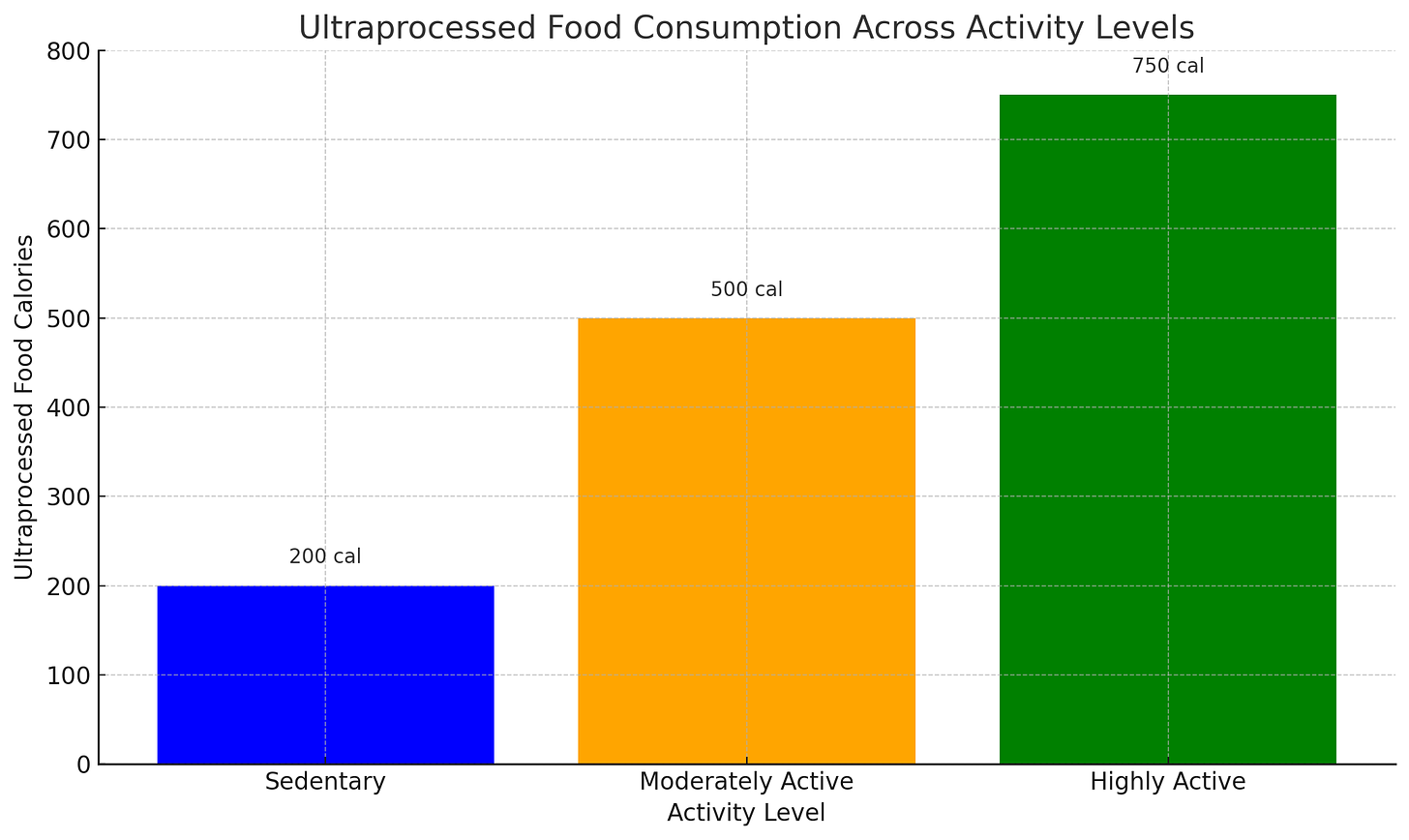Post summary
The diets of the athletes at the Paris Olympics aren’t what you might expect.
But unpacking why Olympians eat the way they do can help us understand:
How to eat to fuel different levels of exercise/activity.
Why “junk food” can improve your fitness in certain workouts.
When to eat junk food and how much of it to eat based on your activity level.
An key underlying cause of metabolic diseases.
Why overly restrictive and finicky diets can backfire.
Housekeeping
This post is free to all. Enjoy.
If you want all of our great posts, become a Member of Two Percent.
Audio/podcast version
The post
I’ve talked to hundreds of Olympians about everything from they train to how they get their minds right (I used to cover the Olympics when I was an editor at Men’s Health magazine.)
But I’ve always been most fascinated by Olympian eating habits.
We often think that high performing athletes eat an impeccable diet. Like it’s all perfectly portioned grilled salmon and quinoa and vegetables all the time.
But the truth is much different. In fact, Olympians use an imperfect diet to their advantage.
Let’s start with a story …
For the 2014 Winter Games, I spoke to Olympic bobsledder Chris Fogt. He was part of the famed Night Train team that won gold in 2010 and silver in 2014.
But Fogt almost didn’t make the squad. He was a hell of a runner—bobsled pushmen are basically 100-meter sprinters who shove a 450-pound sled down a starting track and then ride in it afterward.
The problem was that Fogt only weighed 170 pounds.
“As a pushman in bobsledding, you need to weigh about 210 to 230 pounds to add weight to the sled,” Fogt told me. It’s physics: Heavier stuff moves faster downhill, and you want the combined weight of the sled and crew to be as close to the 1,390-pound maximum as possible.
Fogt needed to add 40 pounds to make the team. That 40 pounds had to be mostly muscle so he could still perform.
Fogt’s solution:
1 Cheesy Gordita Crunch
2 Doritos Locos Tacos
1 Beefy Five-Layer Burrito
2 Soft Tacos.
That’s the “snack” Fogt would get from the Taco Bell drive-through after his workouts.
The damage: ~1,700 calories, or roughly three-quarters of your daily caloric intake.
Those calories consisted of 83 grams of fat, 166 carbohydrates, 70 grams of protein, and enough sodium to stop the heart of a mule.
But for Fogt, this snack was the key to making weight and bringing home a medal.
“Squats and Taco Bell, baby,” he said.
The strange range of Olympian eating habits
That’s not to say all Olympians are pounding thousands of calories in fast food. There are Olympians who run their nutrition as a meticulous spreadsheet.
For example, the NYT recently ran a story on Olympian breakfasts, which featured a few details of the track and field athlete CJ Allen’s eating plan. He begins his day with an 11-ingredient smoothie packed with a list of obscure supplements that sounds like a podcast ad read for Onnit nutrition.
But the details of many other athletes’ diets sound more like the nutritional fever dream of a seven-year-old. For example:
Haley Batten, on Team USA Mountain Biking:
Pancakes topped with bananas and maple syrup for breakfast.
Pop-Tarts while on the bike (Two Percent take: Frosted Strawberry or GTFO).
Luke Willian, the Australian triathlete:
A giant bowl of cornflakes and whole milk for breakfast.
Gummy bears and a 200-calorie electrolyte drink (like Gatorade) while training.
Two salami-and-cheese sandwiches and a cake bite after training (he’s eaten this entire list before 10am.)
Asia Hogan-Rochester, the Canadian rugby player:
“Granola with almond milk, watermelon, a croissant, yogurt and a few sides of chicken dim sum sausage, brie cheese and veggie pierogies” for breakfast.
Maggie Mac Neil, the American swimmer.
Ice cream. Lots of it.
Lee Kiefer, the American fencer:
Crumbl cookies in all of their 800-calorie glory.
Why it works
That list might send internet nutrition warriors into a tailspin of pontification about how sugar is toxic and the grim reaper knocks at your door anytime you eat white bread or processed red meat.
But for Olympic athletes, those type of foods can actually be helpful.
To understand why, I spoke with Brian St. Pierre, a sports nutritionist who has worked with Olympians and consulted for pro teams like the Cleveland Browns and San Antonio spurs.
As far as health-effects go, Fogt’s burrito benders—and the Pop-Tarts and gummy bears and Crumbl cookies of the other Olympians—are a non-issue.
St. Pierre explained that Olympic athletes who train constantly have high calorie demands1, so they’re able to metabolize junk food and remain healthy so long as they aren’t insufficient in calories, vitamins, and minerals.
Take Fogt. “I train 20 to 30 hours a week,” he said. “So I eat about 6,000 calories a day.” Some swimmers, cyclists, and marathoners might need as many as 8,000.
And Fogt wasn’t only eating Taco Bell. “I also eat the healthy stuff that our trainers and dietitians tell me to,” he told me.
For many athletes, junk food isn’t just an indulgence—it can also give them an edge.
The surprising junk food edge
Trying to eat entirely healthy food all the time can backfire.
As a general rule, the more we process a food, the more we concentrate its calories.
I.e., An ounce of ultraprocessed/junk food usually contains far more calories than an ounce of whole/unprocessed food.
Here’s a chart visualizing this. It shows the number of calories per ounce of different foods:
“Eating 1,700 calories in chicken breast, broccoli, and potatoes would take you 45 minutes. You’d have to put time into preparing it, and you’d fill up really fast because of high fiber and water content,” St. Pierre told me. “1,700 calories of Taco Bell takes about 10 minutes to eat and 2 minutes to order.”
Taco Bell, gummy bears, croissants, skittles, and other hyper-processed foods pack many calories into a small, convenient, and delicious package.
Athletes use that to their advantage.
These foods take up less room in your stomach, so the athletes don’t feel overly full and bloated while training.
Using the example of an apple versus a candy bar from the graph, to get 140 calories from apples, you’d have to eat roughly 8 to 10 ounces of apples. A candy bar packs that same punch in just 1 once.
These foods are already processed, so the athletes’ stomachs have to do less work breaking down the food for energy. This can help them avoid stomach issues while exercising.
Learn more about that topic in this Two Percent post: A Smarter Perspective on Sports Nutrition.
These foods are convenient. Taco Bell is already prepared. A Pop-Tart sits inside a foil sleeve that can be easily shoved into a pocket. That makes it easier for the athlete to eat while on the go.
Restriction backfires
The nutritionists at the Olympic training center also say that being too finicky about food often hurts athletes. It can lead to undereating, which hurts performance and recovery.
For example, undereating is a big driver of training injuries and fatigue.
Hyper-specific diets are also a distraction. To win gold, it’s more useful for athletes to focus on their sport rather than every ounce of food they eat.
Takeaways for you
Again, we’re not advocating you live on Taco Bell and Pop-Tarts.
But our food environment is filled with ultraprocessed foods that are hard to resist. We inevitably eat them—yet we could always eat them smarter, in a way that helps us rather than hurts us. Here are two lessons from athletes to help you do just that.
1. Moving more buys you “more room for junk”
Dr. Trevor Kashey, friend of Two Percent from The Comfort Crisis, said this about type-ii diabetes: “It’s more of a ‘too much couch’ rather than ‘too much carbs’ problem.”
The more you move, the less you have to worry about the health impacts of the less-than-perfect foods you eat.
Whether any one food is “good” or “bad” for you depends on a variety of factors, but especially your activity level. Take added sugar2, for example:
For a sedentary person, added sugar is probably a net negative.
For a marathon runner, added sugar is often a net positive, especially during training.
Here’s a rough guide of how much ultraprocessed food you can get away with eating based on your activity level. I’ve pulled these figures from various recommendations from dietitians.
Sedentary individuals can probably get away with 10 percent of their calories from “junk” foods.
Moderately active people are usually fine if 20 percent of their food is junk.
Highly active individuals can get away with 25 percent.
Here’s what that looks like based on a sedentary person needing 2,000 calories, a moderately active person needing 2,500, and a highly active person needing 3,0003.
2. “Junk food” can power long cardio workouts
Eating the right foods can improve your performance if you’re exercising intensely4 like running or cycling for more than an hour.
Enter ultraprocessed/junk foods, which are uniquely beneficial for endurance exercise.
When you exercise hard, your body prioritizes powering your muscles and puts processes like digestion on the back burner. That helps you run or ride fast, but it also gives your gut fewer resources to extract energy from the food inside it.
As their name implies, ultraprocessed foods have been processed beforehand. This means your stomach doesn’t have to do as much work breaking them down.
“If a food doesn’t require much digestion, your body can immediately start to absorb and use the nutrients from it, and that’s going to improve your performance more than anything,” said Dr. Kashey. It can also help you avoid stomach issues, the number one reason people drop out of races.
This is why the Olympic mountain biker eats Pop-Tarts on the bike and why the triathlete eats gummy bears.
A good rule of thumb: Eat anywhere from 120 to 180 calories an hour during efforts lasting longer than one hour.
Have fun, don’t die, strawberry frosted or GTFO.
-Michael
Sponsored by Momentous
Momentous made me feel good about supplements again. Over 150 professional and collegiate sports teams and the US Military trust their products, thanks to the company’s rigorous science and testing. I don’t have the time or desire to cook perfectly balanced meals that give me all the necessary nutrients and protein I need (let’s face it, few of us do!). So I use their Recovery protein during hard workouts; essential multivitamin to cover my bases; creatine because it’s associated with all sorts of great things; and Fuel on my longest endurance workouts on 100+ degree days here in the desert (because Rule 2: Don’t die). And I also love (love!) that Momentous is researching and developing women-specific performance supplements.
**Use discount code EASTER for 15% off.**
Sponsored by Inside Tracker
Your blood holds stories—lots of them. It can reveal critical information about your risk of heart disease, your metabolic health, recovery, endurance, inflammation, and much more. And yet, to get the most important information, you need to go deeper than the lab work your doctor has you do each year.
Enter Inside Tracker, created by researchers at Harvard, Tufts, and MIT. They make it easy to get deep blood work, providing analysis that can tell you about risks in your future and help you make guided decisions that will help you live and perform better, longer. Results from my own tests led me to alter a few health habits, and I’m better for it.
**Use discount code EASTER.**
Sponsored by GORUCK
When I decided to accept sponsorships for this newsletter, GORUCK was a natural fit. Not only is the company's story included in The Comfort Crisis, but I've been using GORUCK's gear since the brand was founded. Seriously. They've been around ~12 years and I still regularly use a pack of theirs that is 11 years old. Their gear is made in the USA by former Special Forces soldiers. They make my favorite rucking setup: A Rucker 4.0 and Ruck Plate.
**Use discount code EASTER for 10% off**
This varies by sport. For example, cyclists, swimmers, marathon runners, and triathletes have reported eating as many as 8,000, while a shooting athletes, archers, and sailors can eat like a “regular” person.
When we say “added sugar,” we’re referring to sugar that is added into the food during processing, not sugar that naturally occurs in whole foods. For example, sugar added to yogurt to make it tasty, the sugar in Skittles, etc.
Again, these are rough estimates. Experiment and learn what works best for you.
Rucking and weight lifting usually aren’t intense enough that you need to replenish calories. On a 2+ hour long ruck, just bring a snack and don’t overthink this.







Brown sugar cinnamon 💪
Wasn't expecting the powerful Pop-Tart opinion, lol! As long as it's frosted, I'm there.